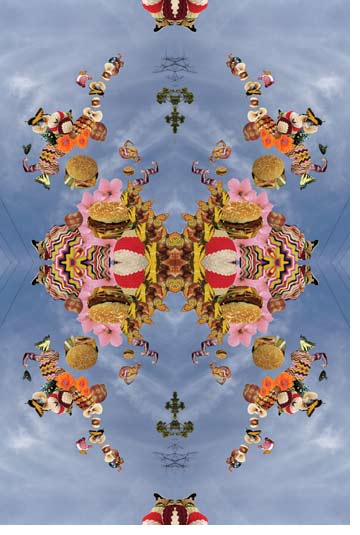Meatpaper
TWO
Eating the Air on Promise of Supply
interview with Barbara Weissberger by Sasha Wizansky
DECEMBER, 2007
 MEAT
IMAGERY turns up frequently in Barbara Weissberger’s
artwork. It appears in the form of collaged hamburger photographs,
detailed watercolors based on cuts of meat, drippy gouaches
of hamburgers with their condiments flying out into nimbuses
of pickles. In 2007, Weissberger was awarded a Guggenheim
Fellowship. Recently, Meatpaper had the opportunity to ask
her about the role of meat in her work. MEAT
IMAGERY turns up frequently in Barbara Weissberger’s
artwork. It appears in the form of collaged hamburger photographs,
detailed watercolors based on cuts of meat, drippy gouaches
of hamburgers with their condiments flying out into nimbuses
of pickles. In 2007, Weissberger was awarded a Guggenheim
Fellowship. Recently, Meatpaper had the opportunity to ask
her about the role of meat in her work.
“Eating the Air on Promise of Supply” was a banner
that appeared in Pittsburgh during an art festival. Would you
tell us about the title?
The title is a quote from Henry IV, part 2. It refers to Hotspur “who
lined himself with hope / Eating the air on promise of supply
/ Flattering himself in project of a power / Much smaller than
the smallest of his thoughts: / And so, with great imagination
/ Proper to madmen, led his powers to death / And winking leap’d
into destruction.” Sounds sadly familiar. Out of context, “Eating
The Air On Promise Of Supply” suggested something environmentalist
to me, as in using up natural resources through misguided overconfidence.
I used a photograph of the sky — multiplied four times — as
a background. So there’s a somewhat literal connection
between the image and the “air” of the title.
How do you feel the rorschach-like symmetry functions?
Years ago I did a series of small silhouette drawings that
I describe as flash-card-like. They are mostly silhouettes
of fantastic figures and are meant to trigger psychological
association. The Rorschach — if slightly hokey — taps
into this idea of associative thinking and invites the viewer
into a receptive state. I’m interested in the pleasure
found in pattern and decorative structure. Then there’s
the dissonance that happens when you get close and see the
strange combinations of cuts of meat and butterflies, or cut
up muscle-bound arms and trippy patterned shapes made of mirrored
doublings of fragments of crocheted blankets.
Cuts of meat
and hamburgers have been a consistent, iconic thread in your
work. When did you start using meat imagery?
The hamburger
entered my work several years ago the way most imagery does,
through play and following narrative lines. I had been making
cartoon/comic inspired drawings with lots of hungry figures.
There is a certain machoness to meat and yet feminist
artists have used meat to investigate issues related to the
body. And now, significantly, meat production is emblematic
of the larger issue of sustainability.
What are the associations that meat imagery has for
you?
I was thinking about greediness, and alternately about the
Hungry Ghost stuck in a perpetual state of unsatiated craving — the
hamburger popped up in that context. The hamburger is cheap
and ubiquitous, a great icon for consumer culture. I find
it funny as a subject. I also like that it is one of the
great American icons. The hamburger led to cuts of beef and
pork.
Do you consider yourself part of a lineage of artists who
consider meat in their work?
I do see myself as part of a lineage that includes Francis
Bacon’s meat and flesh, or Soutine’s paintings
of meat.
Your recent watercolors combine cuts of meat, details of human
muscle from muscle magazines, crocheted blankets, butterflies,
and other imagery. How do you describe what is created from
this combination of elements?
A super-sized, dizzying, cobbled-together world that attempts
to reflect our own.
I started with the meat/muscle combinations.
Flesh obviously connects the cuts of meat and human muscle.
Because of that connection, the initial iteration of this work
was more visceral than I wanted. So I decided to add other
imagery — sweeter
imagery like butterflies and flowers. Advertising likes to
do this: temper the body’s messiness with so-called pretty
images of nature.
As the series develops, the vocabulary of
imagery expands. I am interested in how collage creates its
own logic — the
synergy of odd pairings. My source is a growing archive of
photographs — my own and collected. I categorize the
imagery as either the product of culture or of the natural
world. The meat and muscles are both: processed, enhanced,
transitional.
You’ve written that Fast Food Nation and The
Omnivore’s
Dilemma have inspired your recent watercolors. How does the
current culture of meat influence your studio practice?
Coming from the perspective of The Omnivore’s Dilemma,
it’s not hard to look at food production as a nexus for
larger issues: environmental, economic, and social. How we
produce and consume speaks to our relationship to the planet
and to other species.
I find meat particularly interesting
because as a metaphor or symbol it can be considered in several
ways. Embracing meat could be a rejection of vegetarianism
and by extension values linked to the 60s and 70s. There is
a certain machoness to meat and yet feminist artists have used
meat to investigate issues related to the body. And now, significantly,
meat production is emblematic of the larger issue of sustainability.
I somehow feel I should add that I spend a lot of time in
Montana, where I enjoy grass-fed, and non-grass-fed, hamburgers
and steaks. 
This article originally appeared in
Meatpaper Issue Two.

|
